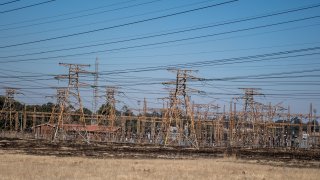South Africa’s New Government Needs Reliable Energy
One of Africa’s largest economies will see economic growth stifled if it continues to focus lopsidedly on wind and solar energy.
What’s the biggest challenge for the African National Congress and its new coalition government now that the ANC has won less than 50 percent of the vote for the first time in thirty years? Most likely it’s ensuring reliable energy supplies, which are necessary for reducing unemployment and reviving the country’s manufacturing sector.
Energy resilience and reliability are vital. For over fifteen years, South Africa, whose electricity depends on coal, has been plagued by blackouts lasting anywhere from two to eight hours a day. Power failures, termed “load shedding,” rose from 176,000 megawatts in 2007 to almost 20 million megawatts in 2023. South Africans have a smartphone app that informs them when load shedding will occur.
Blackouts have damaged the economy. Between 2012 and 2022, South Africa’s GDP per person declined by 17 percent, from $8,174 to $6,766, and manufacturing output decreased by 9 percent. The latest official unemployment rate is 32.1 percent.
The new coalition government’s task is to revive what used to be Africa’s most prosperous economy, focusing on agriculture, mining, and manufacturing. The fundamental condition for recovery is access to reliable, resilient, and affordable power. This calls for making use of South Africa’s domestic supplies of coal and natural gas from the Karoo region (as well as imports from neighboring Mozambique). Renewables are insufficient.
As blackouts rose, so did the share of electricity generated by solar and wind. Between 2012 and 2022, as GDP and manufacturing declined, the use of wind and solar rose from practically zero to about 6 percent. Further development is in the works. The Sere Wind Farm on the Western Cape and the Run-of-River Kakamas Hydro Electric Power facility form part of the government-run electricity utility’s (Eskom) 2020 Renewable Energy Utility Solution that supposedly “will allow all our customers to source up to 100 percent of their electricity from Eskom’s renewable sources.”
However, because wind and solar do not run continuously, they need backup natural gas plants or batteries to operate, and intermittent energy costs more than continuous energy.
South Africa’s grid is also limited in that it cannot accept intermittent power from renewables. Eskom is too financially strapped to extend and fix the grid.
The new government needs to discard its National Development Plan 2030, published in 2019, which seeks to replace inexpensive domestic coal with renewables. The plan is justified as equitable, inexpensive, and clean, but the cost of integrating these technologies into the grid is high.
The United States has given South Africa $1 billion for its Just Energy Transition Project to expand renewables, and the World Bank in 2022 loaned $440 million of a $500 million loan to decommission the Komati coal plant and replace it with wind and solar power. However, wind and solar are more expensive than coal, which South Africa has in abundance.
The World Energy Council’s Energy Trilemma seeks to balance energy security, energy equity, and environmental sustainability. The excessive focus on environmental sustainability weakens energy security for countries that own fossil fuels, such as South Africa and the United States. Wind and solar drive up electricity prices, reducing energy equity. Tellingly, the 2022 World Energy Issues Monitor contains not one mention of “poor” or “poverty,” yet twenty-five mentions of “transition.”
Costly renewables would not reduce global warming because South Africa is the source of only 1 percent of global emissions. Even if South Africa were to completely abate all emissions, starting now, according to climate models, there would be less than a 0.0101 degree Celsius temperature reduction by 2050 and a 0.0213 degree Celsius temperature reduction by 2100.
Reliable energy availability would allow South Africa’s GDP and manufacturing sector to begin to expand again. This contributes to lower greenhouse gas emissions in the long run.
Climate change is a fact. However, using less energy will make South Africans worse off. It is less expensive to adapt to increases in temperatures than to destroy an economy by phasing out fossil fuels. Unreliable and expensive energy jeopardizes commercial activities, from manufacturing to mining, raising unemployment rates.
The election results show widespread political discontent. The core of the national decline has been the government’s disastrous energy policy, which has slowed economic growth and raised unemployment rates. The new coalition needs to move fast to provide a secure fossil fuel-based energy supply to underpin economic growth.
Diana Furchtgott-Roth, former chief economist of the U.S. Department of Labor, directs The Heritage Foundation’s Center on Energy, Climate, and Environment.
Image: Poetry Photography / Shutterstock.com.

